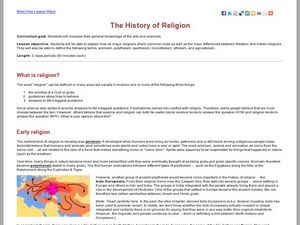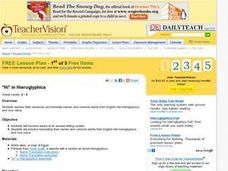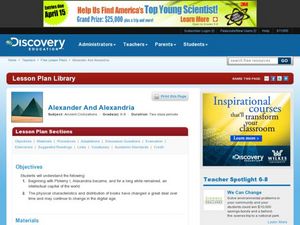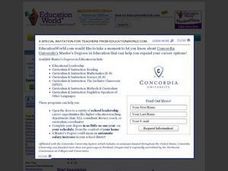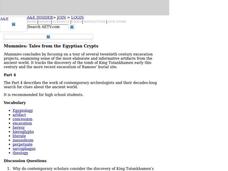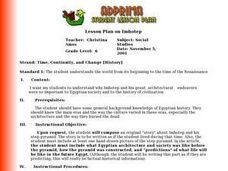Curated OER
Exploring & Creating Mythology
Learners read and compare mythological stories from ancient cultures from around the world. In small groups they read a myth and present the storyline and themes to the class, and write an original mythological story of their own...
Curated OER
The Persian Empire
In this the Persian empire worksheet, students read a two page passage about Persia, then answer 5 multiple choice and 7 short answer questions requiring research about the topic.
Curated OER
The History of Religion
Students learn about the two main types of religions. In this religion lesson, students define religion and learn about early religion as well as religion in the west. Students define animism, polytheism, pantheism,...
Curated OER
Africa Test Study Guide
In this Africa study guide learning exercise, students respond to 27 short answer questions about the geography and history of the continent.
Curated OER
Prayers for Paankhenamun
Students use the internet to research one of six Egyptian gods and goddesses of the afterlife. They focus on physical attributes, symbols associated with and the role played by that deity into the afterlife. They write a letter to their...
Curated OER
The Uluburun Shipwreck Project: Interconnections through Trade in the Late Bronze Age Mediterranean World
Ninth graders examine causes and effects of the Uluburun shipwreck. In groups, they develop their own ways to categorize the artifacts found on the ship and decide on the research questions they are going to focus on. They use the...
Curated OER
"Hi" in Hieroglyphics
Young scholars locate Egypt on a world map. They discover the use of the ancient writing system of hieroglyphics. They practice writing their name and translating words to hieroglyphics
Curated OER
Primary Sources and Archaeology in the Study of Ancient Mediterranean Trade
Tenth graders begin the lesson by plotting trade routes, major empires and items traded. Using primary sources, they examine their own values regarding trading items for royality. They participate in a role-play exercise in which they...
Curated OER
Egyptian Expedition
Students identify and analyze ancient Egypt and interpret how to develop bibliographical references. They research topics using multiple resources and various forms of media of media. Finally, students practice and deliver an oral...
Curated OER
Thematic Amusement Park Projects
Theme park lesson plans help students learn about history, science, and have fun at the same time.
Curated OER
Elements of Civilization
High schoolers create their own ancient civilizations based off of topographical maps of Egypt, Mesopotamia, the Indus Valley, and the Yellow River. In this social studies lesson, students are assigned one topographical map to use to...
Curated OER
Augustus: First of the Roman Emperors
Students explore how Julius Caesar's military brilliance forged a new Rome, but Augustus' political genius made it an empire for the ages. Despite being Caesar's nephew and adopted heir, Augustus struggled for thirteen years to...
Los Angeles Unified School District
River Systems
Scholars must react to the ecosystems of a river. They use inquiry-based learning along with maps and visuals to better understand the impact of rivers on everyday life. To finish, they create final written projects and presentations.
Curated OER
Alexander and Alexandria
Students explore the history of libraries. In this ancient civilizations lesson, students consider the work of Ptolemy to build a library in Alexandria. Students discuss the availability of books then and today. Students also discuss how...
Curated OER
The Middle East: Land of Contrasts
Young scholars explore the ancient city of Petra. In this Middle East lesson, students watch "The Royal Tour of Jordan," and then discuss the history of Petra. Young scholars conduct research on selected sites in the city and use their...
Curated OER
Make A Mummy: The Science of Mummification
Learners research the history of mummification. They work together to create an apple mummy. They write a paragraph about what they gathered while doing the experiment.
Curated OER
Prayers for Paankhenamun
Students find out about key attributes, characteristics, and roles of ancient Egyptian gods and goddesses by writing a letter or a poem asking them to welcome an Egyptian to the afterlife.
Curated OER
Chapter 9: A Surprising Day and A Little Bit About China
Fifth graders complete activities with Chapter 9 of the book The Fastest Pig in the West by Randi Hacker. In this literature lesson, 5th graders discuss the concept of saving face and how it affects the main character's decisions....
Curated OER
Role Playing the Plague
Students investigate the impact of the plague. In this European history lesson, students listen to their instructors present information regarding the black death and then write letters regarding the plague from the perspective of 14th...
Curated OER
Mummies: Tales from the Egyptian Crypts Part IV
Students choose one or two of the artifacts found in King Tutankhamen's tomb and describe and analyze the artifact. Explain what it tells us about Tutankhamen's life and about ancient Egyptian culture.
Curated OER
Imhotep
Sixth graders compose an original story about Imhotep and his step-pyramid. They also must include what Egyptian architecture and society was like before the pyramid, how the pyramid was constructed and predictions of what life will be...
Curated OER
The Empires of Early Africa
Students view the video "Empires of Early Africa." They are asked: Who was Nefertiti? They review the facts about Akhenaten and Nefertiti. Students discuss how archaeologists looked for clues to determine the identity of the mummy...
Curated OER
Anasazi Basket Weaving: 0-500 A.D.
Sixth graders study Period 1- Basket Maker 0-500 A.D. of Anasazi Culture. They identify the sequence of history in Anasazi Culture and Indians of the Mesa Verde. They discover American Indian contributions to the world and develop...
Curated OER
Anasazi Pueblo Period: 700-1050 A.D.
Sixth graders study Period 3-Developmental Pueblo 700-1050 A.D., of Anasazi culture. They identify the sequence of history in Colorado and recognize American Indian Contributions to the world. They study Indians of the Mesa Verde and...


